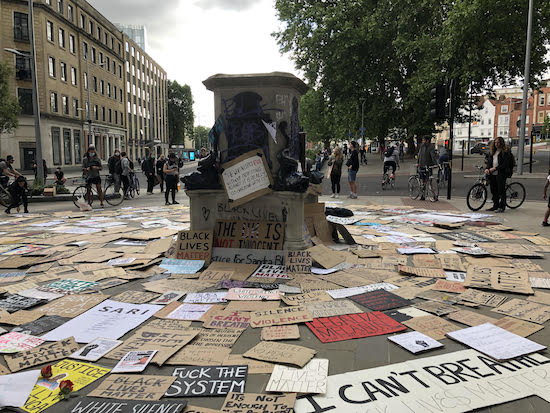Bristol’s latest contribution to the art world has been an instant smash hit. Images of the Colston statue repositioning were beamed around the world, first by social media and then by mass media, that afternoon. Historians and political pundits were interviewed about it on the evening news. Even the Home Secretary got involved, calling for the anonymous artists to be named.
Like every great work of art, this repurposing of an old statue of a slave trader has pushed back the boundaries of its genre. Guerrilla artworks, a Bristol tradition, are normally created in darkness or behind covered scaffolding. By installing their new multi-part sculpture in broad daylight surrounded by a large crowd, these artists ensured that this act of installation was itself a one-off performance artwork.
There is an eerie beauty about the space where the statue used to stand. Its little traffic island has become a place where people of all ages and of different ethnic backgrounds come to spend a little time. It now has that atmosphere of quiet contemplative calm usually found in art galleries and religious buildings.
After the statue went, protestors returned to the plinth to leave their handmade signs all around it. The council gathered these up at the end of the day and are planning to put them in the museum. And for a while, the ionic stone pedestal that had connected the statue with its plinth lay on the pavement, a scene reminiscent of tumbledown graveyards and relics of ancient civilisations. But that has gone too now.
When I was there the next day, one bystander silently stepped up to the podium, took a small bottle of correction fluid from his pocket, changed the plaque’s opening phrase to read ‘rejected by citizens of Bristol’, took some photos, and walked away. Nobody said anything. The next day the plinth was festooned with black balloons and more protest signs had appeared.
Edward Colston enslaved 84,000 people, of whom 19,000 died in his ships. The enormity of his crime against humanity, the sheer affront of that statue, erected to glorify him more than a century and a half after he died, and the final victory of its sudden removal after decades of frustrated campaigning, have imbued the space with a profound significance that is palpable for many of Bristol’s citizens.
From the empty plinth, it is a short walk to the quayside where the statue teetered then toppled into the very same harbour where Colston’s own slave ships used to dock. You can still see the scratch marks in the pavement where it was dragged and rolled along. The hollow form filled up as it bubbled its way down. For a few days, people lingered there too, quietly looking at the water.
The statue could not be seen, even though it was in a public place. Where it had previously stood, there is noticeably nothing. Together these two invisibilities and the space between them formed an entirely new sculpture, infused with meanings and memories, with pain and outrage and release and hope.
Like every great artwork, Bristol’s newest and most innovative sculpture inspired artistic responses. Vanessa Kisuule, the city’s official City Poet, posted her poem celebrating the statue’s downfall on her Twitter feed the very next day. There have been calls for the statue of Henry Dundas, a politician who delayed the abolition of the transatlantic slave trade by fifteen years, to be relocated from Edinburgh city centre into the River Forth.
There will undoubtedly be paintings soon enough, on canvases and on walls, of the iconic images of that day – the statue wrapped in a shroud, the statue unveiled again and with ropes attached, the statue falling to the ground, red paint on its face, a man kneeling on its neck, it being pushed from the harbour wall with ropes bound tightly around its ankles, the splash as it met the water.
The city council destroyed the new sculpture on Thursday morning. They fished the battered old statue out of the water. They used to paint over Banksys too. They should instead have put a plaque on the quayside marking the statue’s hidden presence. Sculpture. Black Lives Matter. Installed by the artists 7 June 2020.
Jonathan Webber lives in Bristol. His book Rethinking Existentialism is out in paperback this summer from Oxford University Press


